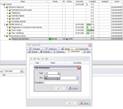 |
|
 |
VIP Task Manager |
 |
|
 |
VIP Task Manager |
|
In Scrum methodology Sprint lifecycle is broken down into four stages:
Sprint planning is held at the beginning of the Sprint. In the process of the planning there are a number of participators concerned to the sprint: Product Owner, Scrum Master and Scrum Team, customers, users, management. Sprint planning consists of two consecutive meetings. On the first meeting, the interested parties meet to specify and set priorities to a reserve of the product properties and a reserve of ongoing release properties. They choose the purposes for the next iteration, usually being guided by the major business tasks and risks. Participators: Team, Product Owner, Scrum Master, users, management. Objective: determine the Sprint Goal and Sprint Backlog. On the second meeting, Scrum Team and Product Owner meet to discuss how to reach defined purposes and to create a task reserve of Sprint (at 4-16 hour splitting). If estimated efforts exceed resources, there is another planning cycle. The reserve of Sprint is corrected often daily at an early stage of iteration as soon as new tasks are found and when iteration comes to an end. With history growth of many Sprint reserves, Team improves quality of creation of the new sprints. Participators: Scrum Master, Team, Product Owner. Objective: determine how to functionality will be worked out in order to reach the sprint. For each element of Sprint Backlog a list of tasks and its duration are determined. If during the sprint it is found out that Team cannot have time to make planned tasks on the sprint, Scrum Master, Product Owner and Team hold a meeting and find out, how it is possible to reduce scope of works and so to achieve Sprint Goal. |
||
The sprint stop is made in exclusive situations. Sprint can be stopped before 30 days will end. Sprint can be stopped if Team understands that it cannot achieve Sprint Goal during defined time. Product Owner can stop Sprint if there is a necessity for achievement of Sprint Goal has disappeared. After Sprint was stopped stop there is a meeting with Team where the reasons of Sprint stop are discussed. Further a new Sprint begins. |
||
This meeting passes every morning at the beginning of day. It is aimed that all Team members know who and what is engaged in the project. Duration of this meeting is strictly limited and should not exceed 15 minutes. The meeting purpose is to share the information. It is not intended for the decision of issues in the project. All questions demanding special discussion should be taken out of meeting limits. Daily Scrum meeting is held by Scrum Master. He asks question and each team member answers these three questions:
| ||
Scrum Team demonstrates the product increment created for last sprint. Product Owner, management, customers and users estimate it. Team tells about assigned tasks, about how they were solved, what obstacles were and what issues were unresolved. Based on review the customers and Product Owner can draw conclusions on how the product should be developed further. Scrum Master is responsible for the organization and holding of this presentation. Team helps to make agenda. Preparation for meeting should not take a lot of time (no more than two hours). Recommended duration of the review is up to 4 hours. |
||
|
From the point of view of Sprint lifecycle, VIP Task Manager can be applied as a planner and scheduler. For example, Scrum Master can create tasks that describe agenda of the Demo Review of Sprint or Daily Scrum Meeting. First of all, he should create the task group "Demo Review of Sprint" and insert a number of tasks to describe the review step by step. As Scrum Team is involved in the review, Scrum Master can share the tasks and assign some of tasks to members of Team. Tasks sharing allows Scrum Master to focus on definite tasks and optimize his working hours. Scrum Team will perform assigned tasks and once a task was completed Scrum Master receives notification by email or within the application. |
||
 |
|
 |
VIP Task Manager |




 Play Demo
Play Demo Play Demo
Play Demo